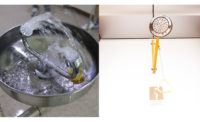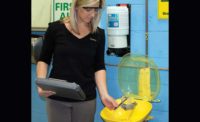15 tips for using showers & eyewashes
When every second counts

- The first 10 to 15 seconds after exposure to a hazardous substance, especially a corrosive substance, are critical. Delaying treatment for even a few seconds may cause serious, permanent injury.
- For chemical exposures and splashes, you need more protection than the use of goggles, face shields and other PPE. Showers and eyewashes are a necessary backup in an emergency to minimize effects of chemical contamination.
- For guidance, use the American National Standards Institute (ANSI) / International Safety Equipment Association (ISEA) Z358.1-2014 emergency equipment standard.
- Evaluate your workplace for high-risk areas, potential hazards, and emergency needs. Safety data sheets help your evaluation by providing information on working with a hazardous substance in a safe manner. SDSs also provide information on a substance’s melting point, boiling point, flash point, toxicity, health effects, first aid, reactivity, storage, disposal, PPE and spill handling procedures.
- The ANSI/ISEA standard defines “flushing fluid” as any potable (drinking) water, preserved water, preserved buffered saline solution, or other medically acceptable solutions.
- The standard does not specify how long the affected body part should be flushed or rinsed. It does require equipment to be capable of providing a minimum of 15 minutes of flushing liquid.
- Other references recommend a minimum of 20-minute flushing if the nature of the contaminant is not known.
- If the properties of the chemical are known, flushing or rinsing times can be modified: 5 minutes for non-irritants or mild irritants; 15-20 minutes for moderate to severe irritants and chemicals that cause acute toxicity if absorbed through the skin; 30 minutes for most corrosive; and 60 minutes for strong alkalis, such as sodium; potassium or calcium hydroxide.
- If irritation persists, repeat the flushing procedure. It is critical to get medical attention as quickly as possible.
- Emergency showers are designed to flush the user’s head and body. They should not be used to flush the user’s eyes. The high rate or pressure of water flow could damage eyes.
- Eyewash stations are designed to flush the eye and face area only. There are combination units containing both a shower and an eyewash.
- ANSI/ISEA recommends that a person be able to reach showers or eyewashes in no more than 10 seconds. Remember, the victim may not have use of their vision. The standard notes that the average person can walk about 55 feet in 10 seconds – but this does not account for the person’s physical and emotional state in an emergency.
- Showers and eyewashes may be required to be closer to a work station if highly corrosive chemicals are being used.
- Water temperature should be “tepid” – between 60-100˚F. Temperatures higher than that are harmful to eyes and can enhance chemical interaction with skin and eyes. Long flushing times with cold water can cause hypothermia and may result in not rinsing or showering for the full recommended time.
- Showers and eyewashes should be on an unobstructed path; be easily visible; on the same floor as the hazard; and near an emergency exit so emergency response personnel can easily reach the victim.
Sources
The Canadian Centre for Occupational Health and Safety (CCOHS) and the International Safety Equipment Association.
Looking for a reprint of this article?
From high-res PDFs to custom plaques, order your copy today!







